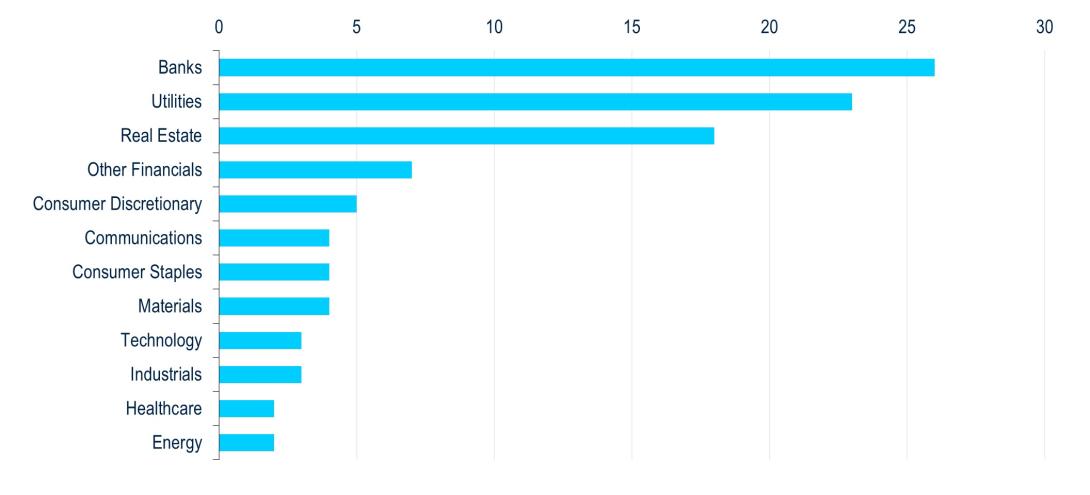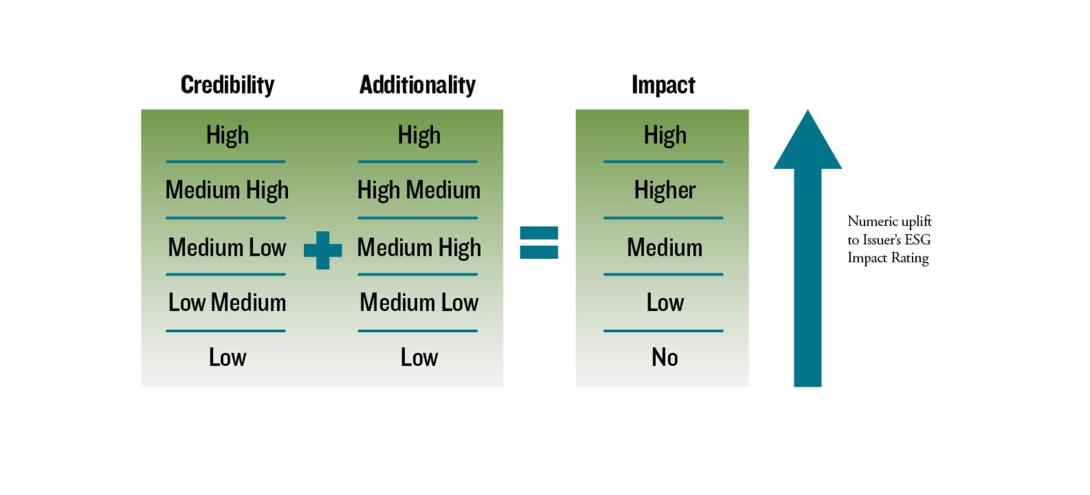The Surprising Lack of ESG in ESG-Labeled Real Estate Bonds

Not all ESG bonds are created equal. Many of them, particularly within the real estate sector, often lack “additionality,” which is one of the key measures that we assign to the incremental positive social or environmental impact created by an ESG-labeled bond as part of our assessment of its quality.
Real Estate Investment Trusts (REITs) issued $42 billion worth of green, social, and sustainability (GSS) bonds in 2022, but most of the proceeds were used to purchase green buildings, a practice we believe carries very little additionality. Currently isolated to Europe, a new trend has also emerged where some REITs are giving traditional bonds an ESG label several years post issuance. Our analysis of these newly “requalified” bonds and REIT issuances with proceeds allocated to purchasing green buildings suggests they don’t provide the positive environmental impact ESG investors are seeking, making many of these securities less suitable for inclusion in ESG-oriented portfolios.
The effortlessness of ESG issuance in real estate
Since the generation of electricity and heat used in buildings is responsible for around 19% of total global CO2 emissions, green bonds could play a critical role in decarbonizing real estate portfolios.1 According to the Climate Bonds Initiative, a hefty one-quarter of total GSS bond proceeds have historically been used to purchase green buildings, which are resource-efficient buildings that have received one of the few, rigorous independent certifications needed to be considered “green” according to the International Capital Markets Association’s (ICMA) Green Bond Principles – the gold standard used to determine which capex projects meet eligibility for green bond proceeds. Notably, buying a green building is one of the few projects specified by ICMA that involves simply purchasing an asset, as opposed to making transformational, but perhaps more complex, investments to help transition an issuer’s existing property, plant, and equipment. This may partially explain why green bond issuances are so common for REITs and why the real estate sector makes up the third largest share of GSS bonds in the Bloomberg Global Corporate Index (Figure 1).
Figure 1: Real Estate Accounts for 18% of GSS Bonds in the Bloomberg Global Corporate Index (%)

Source: PGIM Fixed Income, Bloomberg. As of February 12, 2022.
It’s not uncommon for a REIT to purchase green buildings as part of its day-to-day operations. After all, there are heavy incentives to do so: in addition to lower energy costs, research has indicated the benefits of greener buildings include higher occupancy rates, higher sale premiums, and better tenant retention.2 This makes it difficult to make the case that the proceeds from a green bond are not just akin to a REIT’s run-of-the-mill capital expenditures.
Put differently, are the funds from an ESG-labeled bond issued by a REIT that’s only purchased green properties the last five years actually funding new, transformational projects that would not have occurred without the issuance?
Also reducing the additionality of ESG real estate debt is that at an aggregate level, transferring ownership of an asset from one owner to another has no absolute impact on the environment if other assets are not concurrently being redesigned to be more resource efficient. This is why, for example, many ESG investors prefer engagement to simple divestment. Certainly, purchasing a green building is better than purchasing a non-green building, and a REIT should get credit for having a substantial portfolio of green properties. But REIT issuances with proceeds that fund other, more transformative eligible green projects, such as retrofitting existing buildings to improve their energy efficiency or constructing on-site solar, provide more additionality.
Plain vanilla to ESG
Another questionable trend that’s emerged involves a handful of European REITs “requalifying” their outstanding bonds as ESG by retroactively changing their prospectuses, often years after the bonds were first issued. Some issuers have also gone to the extent to requalify all of their outstanding debt as green, creating “100% Green Bond” programs. Thus far, this trend has been limited to European REITs, to the tune of $15 billion, or 30% of total European REIT green bonds outstanding.
In a sector where green issuance is so common it may raise eyebrows if an issuer hasn’t tapped the ESG-labeled debt market yet, this has become a quick way for some REITs to improve their ESG profile without taking any new actions, while also taking advantage of the ability to fund portfolio growth on more advantageous financing costs associated with issuing GSS debt. A high-quality ESG-labeled bond allocates capital towards projects that likely would not have been financed in the absence of the issuance, funding activities that aren’t just part of business-as-usual. But if these recently minted ESG bonds weren’t explicitly issued to fund new projects, it’s hard to claim that they help the issuer transition its business model from “brown” to green, or really add value beyond their routine debt financing.
A shrinking “greenium”
Additionally, research has demonstrated that green bonds experience stronger secondary market performance compared to their vanilla counterparts.3 This “greenium” can be partially attributed to higher demand and reduced liquidity as investors in ESG-labeled debt are predominantly institutional buy-and-hold managers. Although estimates vary, some research has identified an average greenium of 4-6 bps, with evidence of higher-quality and more credible green bonds that have been externally reviewed by a Second Party Opinion (SPO) provider commanding a higher greenium.4
Currently, we see no evidence the secondary market is pricing requalified REIT bonds any differently than typical ESG-labeled real estate debt. As the market becomes better at discerning high quality GSS bonds from those of lesser quality, we anticipate the greenium associated with requalified bonds to gradually diminish over time, and trade more in line with their vanilla counterparts.
The big takeaway
As part of PGIM Fixed Income’s security selection process, we assess each ESG-labeled issuance based on the overall credibility and additionality of the bond (Figure 2). The higher the individual green bond’s impact, the more attractive the issuance might look for our ESG-focused strategies.
Figure 2: Additionality Factors into an ESG-Labeled Bond’s Impact Assessment

Source: PGIM Fixed Income
However, given some of the trends outlined above, our analysis has found that the majority of REIT green bonds receive a “low” impact rating, which is well below the ratings we see across non-REIT corporate ESG-labeled issuances.
Ultimately, we need to recognize some ESG-labeled bonds make a bigger impact than others. While GSS use-of-proceeds bonds have the potential to improve the environmental profile of existing building stock, one of the largest global sources of greenhouse gases, evidence has shown that up until now, such instruments have been employed by issuers to reward themselves for naturally growing their portfolios or simply requalifying outstanding issuances. We have concerns about the caliber of these “requalified” bonds and question whether ESG-labeled debt issued to purchase green buildings makes the positive impact ESG investors are seeking. Therefore, we are far less likely to buy GSS bonds issues by REITS for our ESG-focused portfolios. We anticipate these trends might also creep into other sectors where issuers have historically been funding eligible green or social projects as part of their day-to-day operations, like financials, or sectors where issuers may have a significant amount of eligible green assets on their balance sheet, like utilities. Active fixed income managers with the capabilities to look beneath the surface of ESG-labeled debt will continue to be better positioned to ensure ESG-labeled debt meets the needs of ESG-oriented investors.
Read More from PGIM Fixed Income
1 IEA (2022), Buildings, IEA, Paris. September 2022.
2 International Finance Corporation, “Green Buildings: A Finance and Policy Blueprint for Emerging Markets,” 2019.
3 Climate Bonds Initiative, “Green Bond Pricing in the Primary Market,” July-December 2021.
4 European Central Bank, “Pricing of Green Bonds: Drivers and Dynamics of the Greenium,” September 2022.
The comments, opinions, and estimates contained herein are based on and/or derived from publicly available information from sources that PGIM Fixed Income believes to be reliable. We do not guarantee the accuracy of such sources or information. This outlook, which is for informational purposes only, sets forth our views as of this date. The underlying assumptions and our views are subject to change. Past performance is not a guarantee or a reliable indicator of future results.
Source(s) of data (unless otherwise noted): PGIM Fixed Income as of February 28, 2023.
For Professional Investors only. Past performance is not a guarantee or a reliable indicator of future results and an investment could lose value. All investments involve risk, including the possible loss of capital.
PGIM Fixed Income operates primarily through PGIM, Inc., a registered investment adviser under the U.S. Investment Advisers Act of 1940, as amended, and a Prudential Financial, Inc. (“PFI”) company. Registration as a registered investment adviser does not imply a certain level or skill or training. PGIM Fixed Income is headquartered in Newark, New Jersey and also includes the following businesses globally: (i) the public fixed income unit within PGIM Limited, located in London; (ii) PGIM Netherlands B.V., located in Amsterdam; (iii) PGIM Japan Co., Ltd. (“PGIM Japan”), located in Tokyo; (iv) the public fixed income unit within PGIM (Hong Kong) Ltd. located in Hong Kong; and (v) the public fixed income unit within PGIM (Singapore) Pte. Ltd., located in Singapore (“PGIM Singapore”). PFI of the United States is not affiliated in any manner with Prudential plc, incorporated in the United Kingdom or with Prudential Assurance Company, a subsidiary of M&G plc, incorporated in the United Kingdom. Prudential, PGIM, their respective logos, and the Rock symbol are service marks of PFI and its related entities, registered in many jurisdictions worldwide.
These materials are for informational or educational purposes only. The information is not intended as investment advice and is not a recommendation about managing or investing assets. In providing these materials, PGIM is not acting as your fiduciary. PGIM Fixed Income as a general matter provides services to qualified institutions, financial intermediaries and institutional investors. Investors seeking information regarding their particular investment needs should contact their own financial professional.
These materials represent the views and opinions of the author(s) regarding the economic conditions, asset classes, securities, issuers or financial instruments referenced herein. Distribution of this information to any person other than the person to whom it was originally delivered and to such person’s advisers is unauthorized, and any reproduction of these materials, in whole or in part, or the divulgence of any of the contents hereof, without prior consent of PGIM Fixed Income is prohibited. Certain information contained herein has been obtained from sources that PGIM Fixed Income believes to be reliable as of the date presented; however, PGIM Fixed Income cannot guarantee the accuracy of such information, assure its completeness, or warrant such information will not be changed. The information contained herein is current as of the date of issuance (or such earlier date as referenced herein) and is subject to change without notice. PGIM Fixed Income has no obligation to update any or all of such information; nor do we make any express or implied warranties or representations as to the completeness or accuracy.
Any forecasts, estimates and certain information contained herein are based upon proprietary research and should not be interpreted as investment advice, as an offer or solicitation, nor as the purchase or sale of any financial instrument. Forecasts and estimates have certain inherent limitations, and unlike an actual performance record, do not reflect actual trading, liquidity constraints, fee. These materials are not intended as an offer or solicitation with respect to the purchase or sale of any security or other financial instrument or any investment management services and should not be used as the basis for any investment decision. PGIM Fixed Income and its affiliates may make investment decisions that are inconsistent with the recommendations or views expressed herein, including for proprietary accounts of PGIM Fixed Income or its affiliates.
Investing in the bond market is subject to risks, including market, interest rate, issuer, credit, inflation risk, and liquidity risk. The value of most bonds and bond strategies are impacted by changes in interest rates. Bonds and bond strategies with longer durations tend to be more sensitive and volatile than those with shorter durations; bond prices generally fall as interest rates rise, and low interest rate environments increase this risk. Reductions in bond counterparty capacity may contribute to decreased market liquidity and increased price volatility. Bond investments may be worth more or less than the original cost when redeemed. Mortgage- and asset-backed securities may be sensitive to changes in interest rates, subject to early repayment risk, and while generally supported by a government, government agency or private guarantor, there is no assurance that the guarantor will meet its obligations. High yield, lower-rated securities involve greater risk than higher-rated securities; portfolios that invest in them may be subject to greater levels of credit and liquidity risk than portfolios that do not. Investing in foreign-denominated and/or -domiciled securities may involve heightened risk due to currency fluctuations, and economic and political risks, which may be enhanced in emerging markets. Currency rates may fluctuate significantly over short periods of time and may reduce the returns of a portfolio. Commodities contain heightened risk, including market, political, regulatory and natural conditions, and may not be suitable for all investors. Diversification does not ensure against loss.
In the United Kingdom, information is issued by PGIM Limited with registered office: Grand Buildings, 1-3 Strand, Trafalgar Square, London, WC2N 5HR. PGIM Limited is authorised and regulated by the Financial Conduct Authority (“FCA”) of the United Kingdom (Firm Reference Number 193418). In the European Economic Area (“EEA”), information is issued by PGIM Netherlands B.V., an entity authorised by the Autoriteit Financiële Markten (“AFM”) in the Netherlands and operating on the basis of a European passport. In certain EEA countries, information is, where permitted, presented by PGIM Limited in reliance of provisions, exemptions or licenses available to PGIM Limited under temporary permission arrangements following the exit of the United Kingdom from the European Union. These materials are issued by PGIM Limited and/or PGIM Netherlands B.V. to persons who are professional clients as defined under the rules of the FCA and/or to persons who are professional clients as defined in the relevant local implementation of Directive 2014/65/EU (MiFID II). In certain countries in Asia-Pacific, information is presented by PGIM (Singapore) Pte. Ltd., a Singapore investment manager registered with and licensed by the Monetary Authority of Singapore. In Japan, information is presented by PGIM Japan Co. Ltd., registered investment adviser with the Japanese Financial Services Agency. In South Korea, information is presented by PGIM, Inc., which is licensed to provide discretionary investment management services directly to South Korean investors. In Hong Kong, information is provided by PGIM (Hong Kong) Limited, a regulated entity with the Securities & Futures Commission in Hong Kong to professional investors as defined in Section 1 of Part 1 of Schedule 1 (paragraph (a) to (i) of the Securities and Futures Ordinance (Cap.571). In Australia, this information is presented by PGIM (Australia) Pty Ltd (“PGIM Australia”) for the general information of its “wholesale” customers (as defined in the Corporations Act 2001). PGIM Australia is a representative of PGIM Limited, which is exempt from the requirement to hold an Australian Financial Services License under the Australian Corporations Act 2001 in respect of financial services. PGIM Limited is exempt by virtue of its regulation by the FCA (Reg: 193418) under the laws of the United Kingdom and the application of ASIC Class Order 03/1099. The laws of the United Kingdom differ from Australian laws. In Canada, pursuant to the international adviser registration exemption in National Instrument 31-103, PGIM, Inc. is informing you that: (1) PGIM, Inc. is not registered in Canada and is advising you in reliance upon an exemption from the adviser registration requirement under National Instrument 31-103; (2) PGIM, Inc.’s jurisdiction of residence is New Jersey, U.S.A.; (3) there may be difficulty enforcing legal rights against PGIM, Inc. because it is resident outside of Canada and all or substantially all of its assets may be situated outside of Canada; and (4) the name and address of the agent for service of process of PGIM, Inc. in the applicable Provinces of Canada are as follows: in Québec: Borden Ladner Gervais LLP, 1000 de La Gauchetière Street West, Suite 900 Montréal, QC H3B 5H4; in British Columbia: Borden Ladner Gervais LLP, 1200 Waterfront Centre, 200 Burrard Street, Vancouver, BC V7X 1T2; in Ontario: Borden Ladner Gervais LLP, 22 Adelaide Street West, Suite 3400, Toronto, ON M5H 4E3; in Nova Scotia: Cox & Palmer, Q.C., 1100 Purdy’s Wharf Tower One, 1959 Upper Water Street, P.O. Box 2380 - Stn Central RPO, Halifax, NS B3J 3E5; in Alberta: Borden Ladner Gervais LLP, 530 Third Avenue S.W., Calgary, AB T2P R3.
© 2023 PFI and its related entities.
2023-1756
Sign Up Now for Full Access to Articles and Podcasts!
Unlock full access to our vast content library by registering as an institutional investor .
Create an accountAlready have an account ? Sign in
